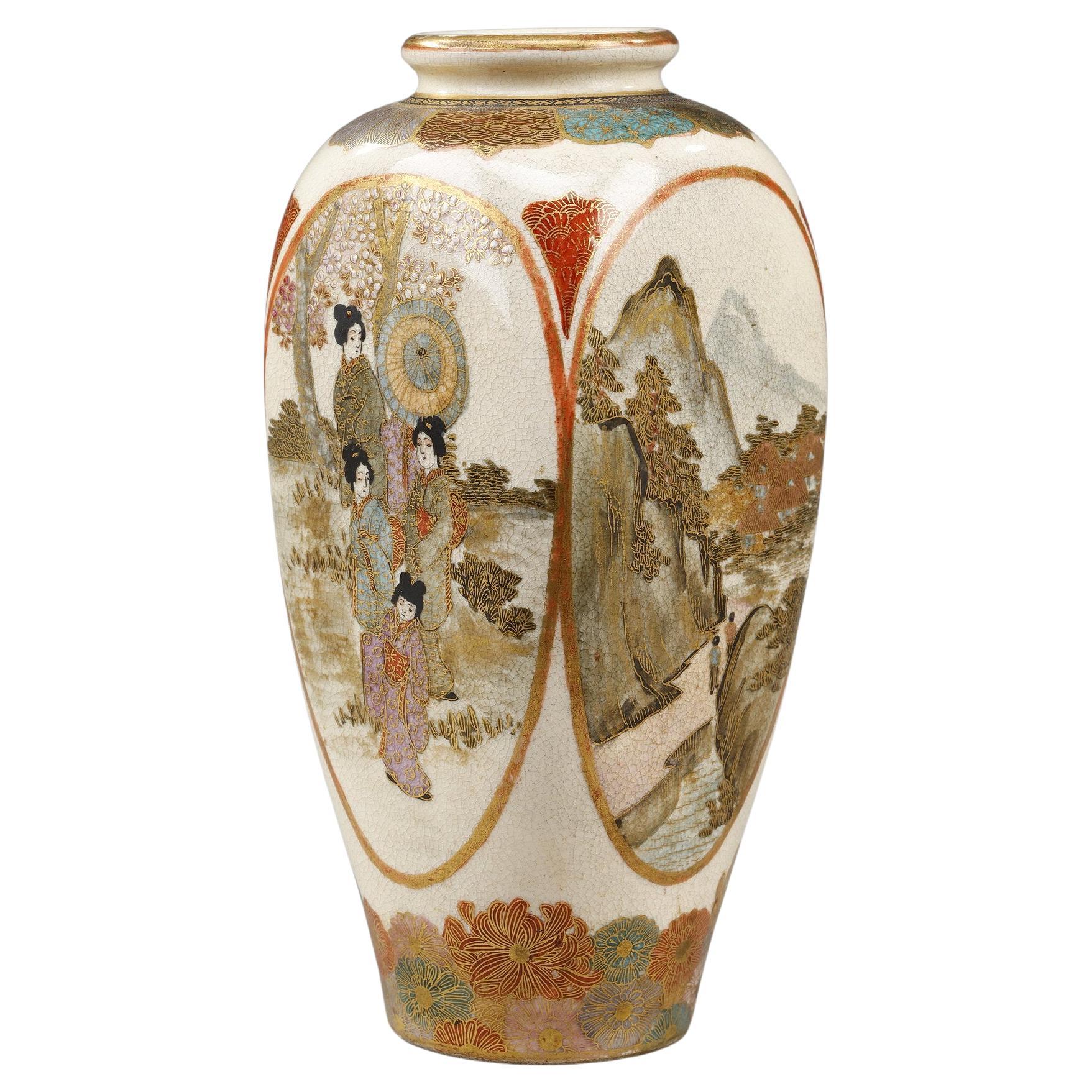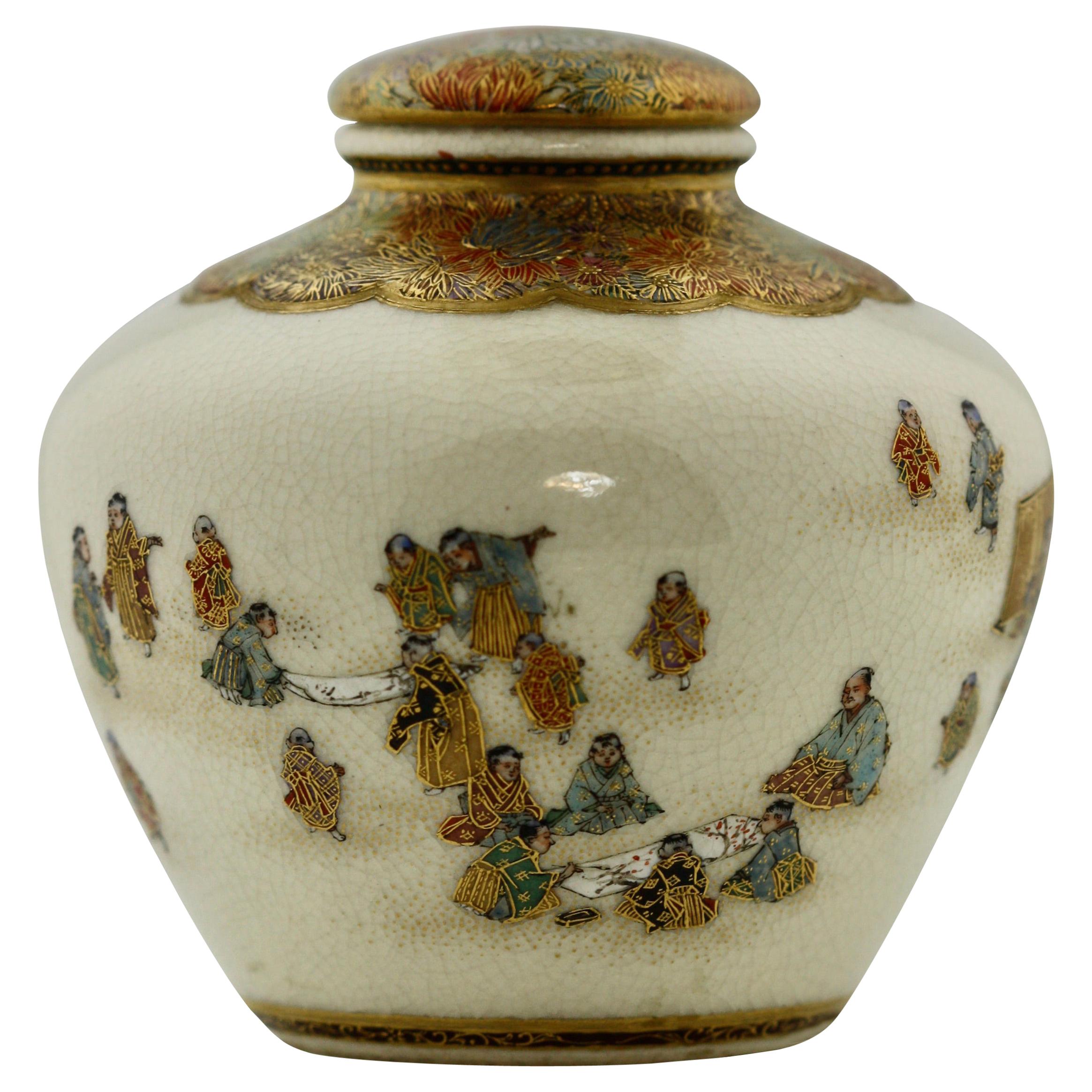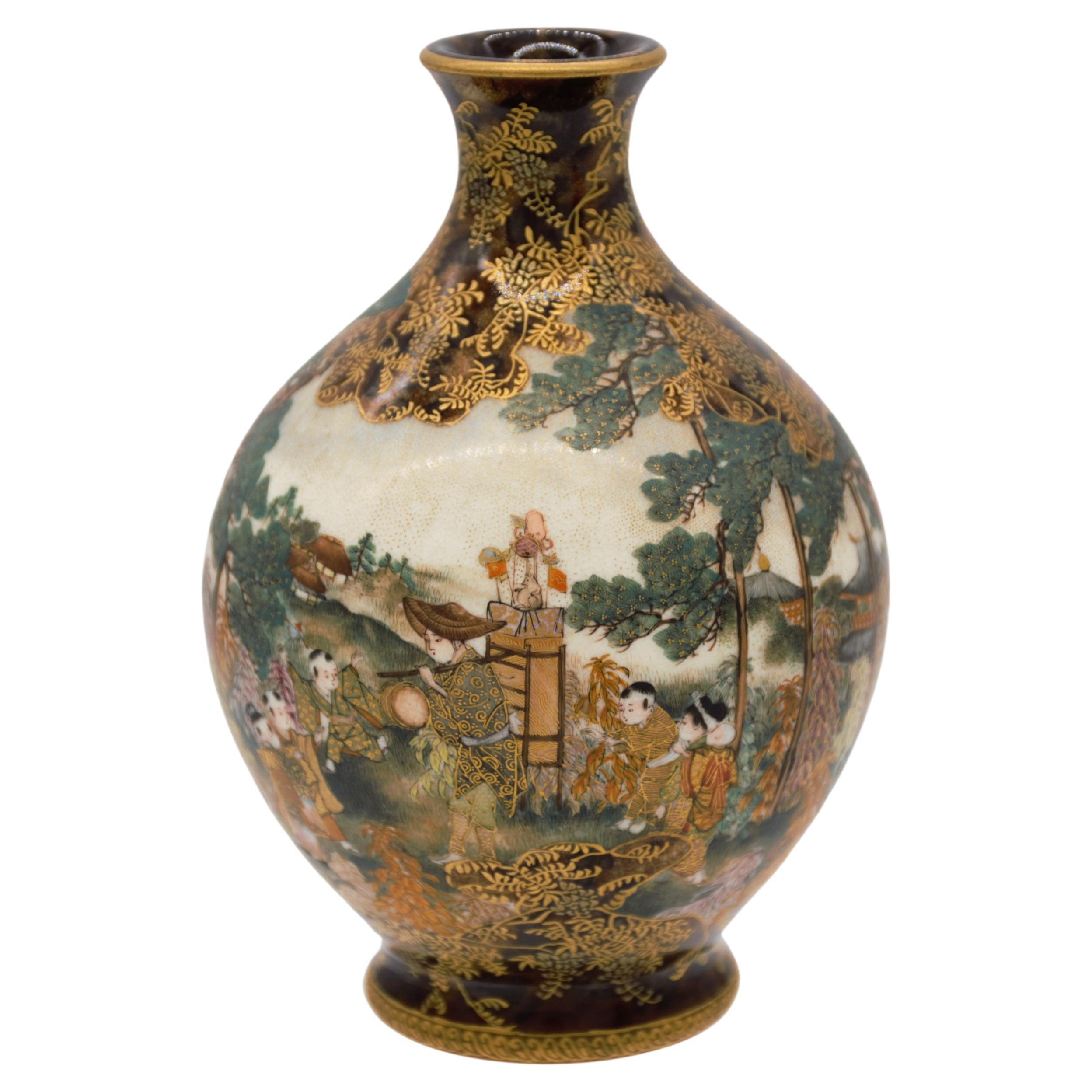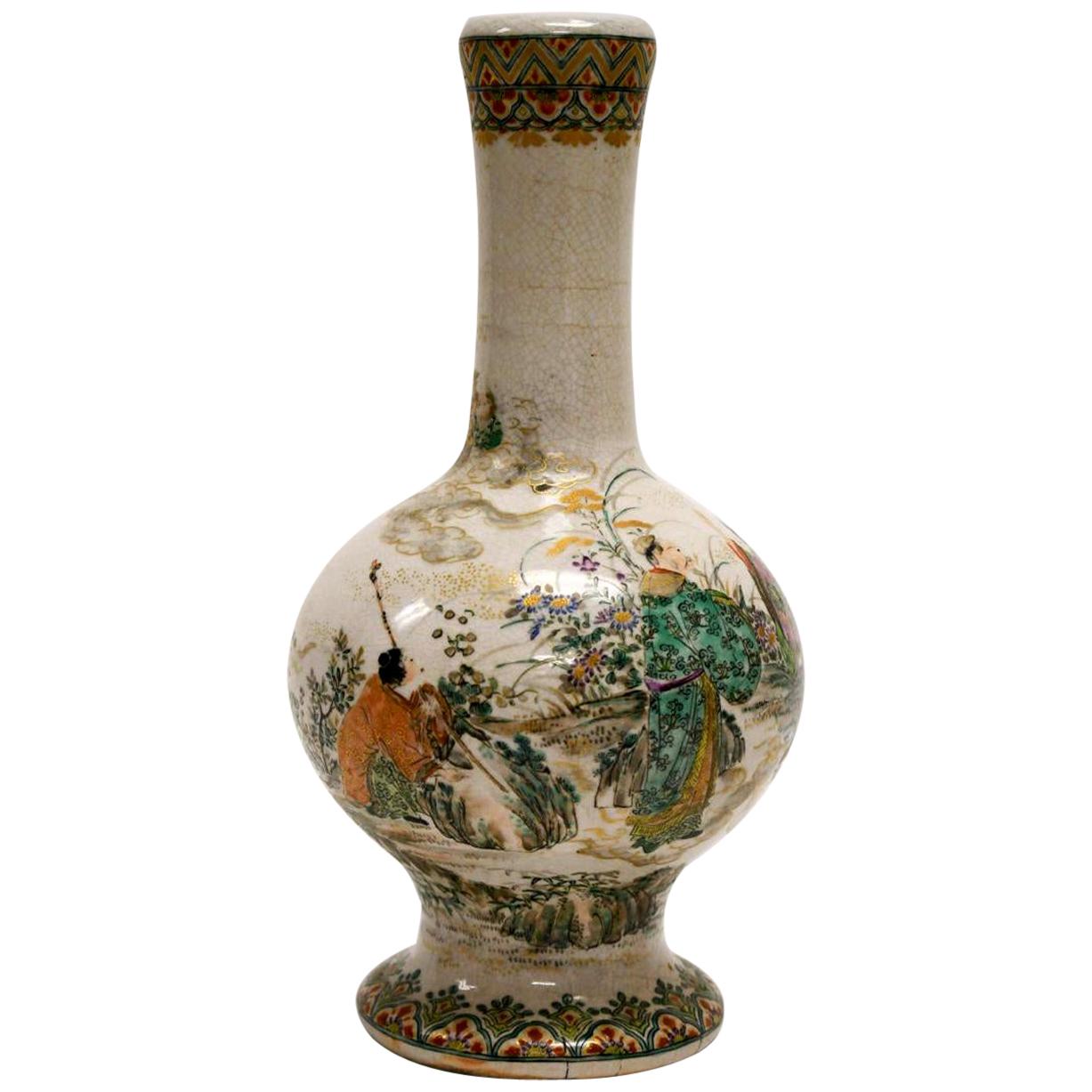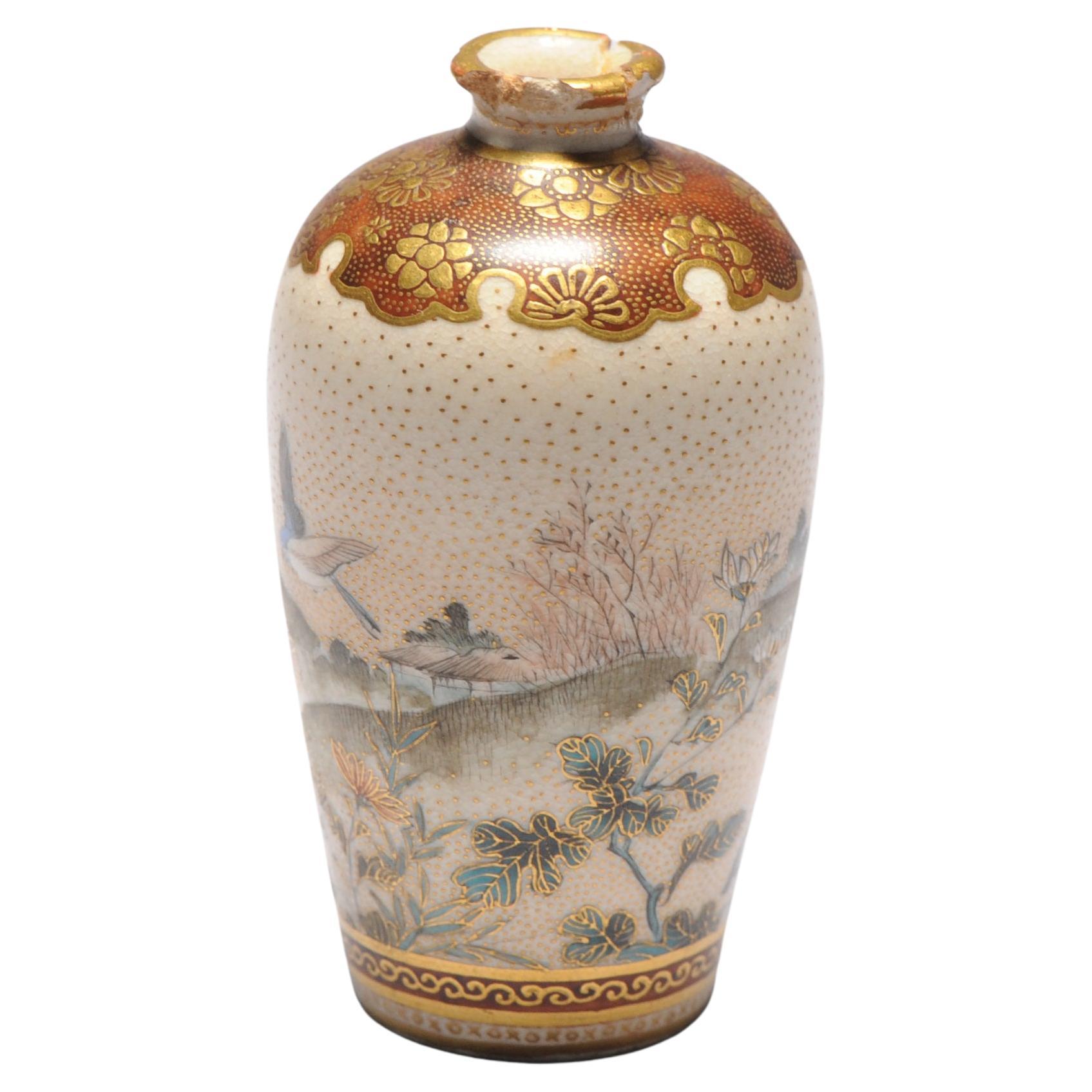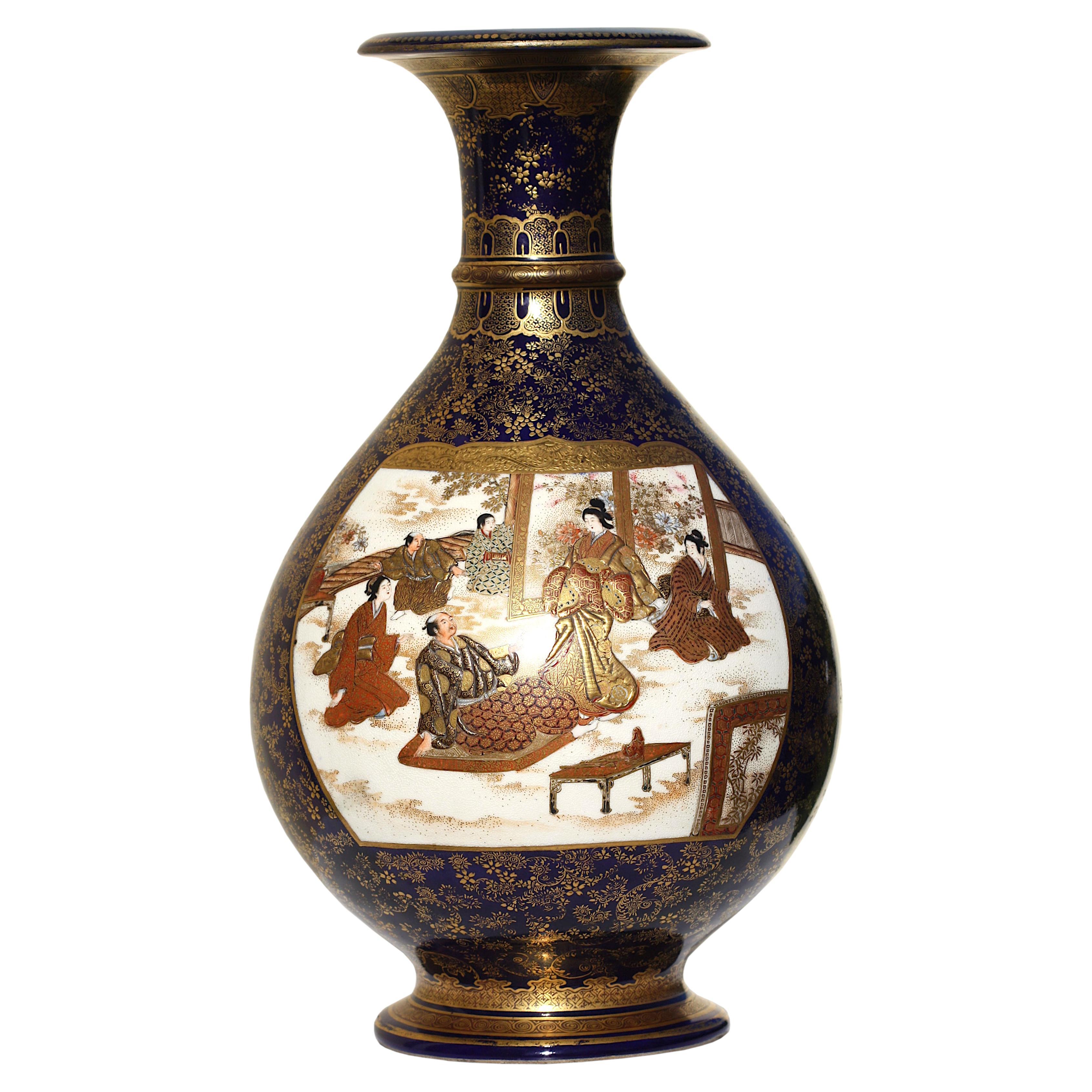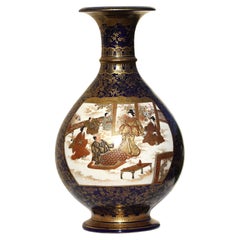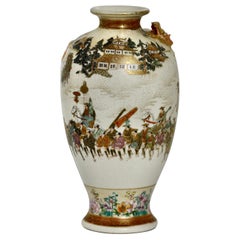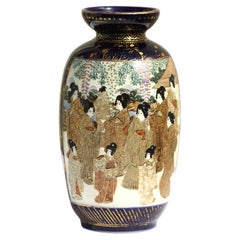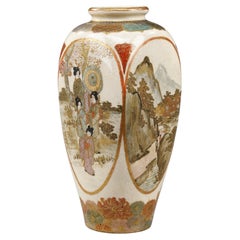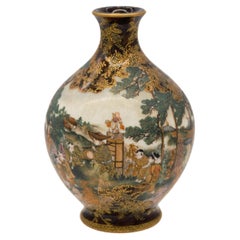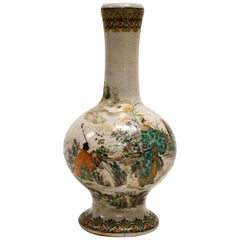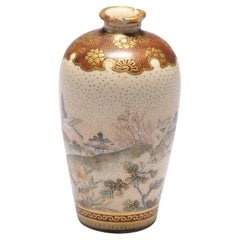Items Similar to Satsuma Earthenware Flat Shouldered Ovoid Vase, Garlic Mouth by Yabu Meizan
Want more images or videos?
Request additional images or videos from the seller
1 of 11
Satsuma Earthenware Flat Shouldered Ovoid Vase, Garlic Mouth by Yabu Meizan
$13,500
£10,321.47
€11,888.25
CA$18,917.64
A$21,119.77
CHF 11,066.44
MX$258,526.66
NOK 140,543.89
SEK 132,515.04
DKK 88,723.21
Shipping
Retrieving quote...The 1stDibs Promise:
Authenticity Guarantee,
Money-Back Guarantee,
24-Hour Cancellation
About the Item
A Satsuma earthenware flat shouldered ovoid vase with garlic mouth by Yabu Meizan,
Osaka, 1853-1934,
decorated in polychrome enamels and gilt over a clear, crackled glaze, delicately painted with women and children engaged in various activities, the foot painted with blossoming plants and the top of the shoulders painted with chrysanthemums and cherry blossoms in a spiral design, with gilt seal Yabu Meizan,
2.75 in. (7 cm.) high.
- Creator:Satsuma (Artist)
- Dimensions:Height: 2.75 in (6.99 cm)Diameter: 2 in (5.08 cm)
- Materials and Techniques:
- Period:
- Date of Manufacture:circa 1890s
- Condition:
- Seller Location:West Palm Beach, FL
- Reference Number:Seller: 01-29-20---91stDibs: LU3860117754332
About the Seller
5.0
Vetted Professional Seller
Every seller passes strict standards for authenticity and reliability
Established in 1989
1stDibs seller since 2018
114 sales on 1stDibs
Typical response time: 10 hours
- ShippingRetrieving quote...Shipping from: West Palm Beach , FL
- Return Policy
Authenticity Guarantee
In the unlikely event there’s an issue with an item’s authenticity, contact us within 1 year for a full refund. DetailsMoney-Back Guarantee
If your item is not as described, is damaged in transit, or does not arrive, contact us within 7 days for a full refund. Details24-Hour Cancellation
You have a 24-hour grace period in which to reconsider your purchase, with no questions asked.Vetted Professional Sellers
Our world-class sellers must adhere to strict standards for service and quality, maintaining the integrity of our listings.Price-Match Guarantee
If you find that a seller listed the same item for a lower price elsewhere, we’ll match it.Trusted Global Delivery
Our best-in-class carrier network provides specialized shipping options worldwide, including custom delivery.More From This Seller
View AllSatsuma Covered Earthenware Vase by Yabu Meizan
By Yabu Meizan
Located in West Palm Beach, FL
A Satsuma covered earthenware vase by Yabu Meizan,
Osaka, 1853-1934,
the compressed ovoid jar fitted with a cover in the manner of a tea jar decorated in polychrome enamels and gilt over a clear, crackled glaze, delicately painted with a continuous design of children playing various games, studying calligraphy and playing music, the cover painted in gilt and chrysanthemums, with gilt seal...
Category
Antique 1850s Vases
Materials
Earthenware
Japanese Satsuma Earthenware Vase by Kinkozan, Meiji Period
By Kinkozan
Located in West Palm Beach, FL
A Japanese Satsuma Earthenware Vase by Kinkozan, Meiji period (1868-1912)
The body inset with two panels, one depicting figures seated around a table, the other painted with a joyful scene in a shrine, all reserved on a blue ground decorated with a gilt flower pattern, signed Nihon Kyoto Kinkozan zo...
Category
20th Century Antiquities
Materials
Ceramic
Japanese Satsuma Earthenware Vase, Meiji Period
Located in West Palm Beach, FL
Japanese Satsuma Earthenware Vase, Meiji Period, 1868-1912, of baluster form, the decorated in poly-chrome enamels and gilt on a clear crackle glaze with a Daimyo procession, the nec...
Category
20th Century Ceramics
Materials
Ceramic
Satsuma earthenware vase
Located in West Palm Beach, FL
Satsuma earthenware vase
the baluster-shaped body painted in enamels and gilt with two panels, one depicting numerous immortals with raised gilt in terraced garden setting, the othe...
Category
20th Century Antiquities
Materials
Ceramic
$1,250
Satsuma earthenware cabinet vase
Located in West Palm Beach, FL
Satsuma earthenware cabinet vase, early 20th century, decorated with ladies and immortals, the long neck flanked by elephant handles, signed.
Height 4.62 in. (11.74 cm.), by 3 in. (...
Category
20th Century Ceramics
Materials
Ceramic
Satsuma Earthenware Vase, by Kinkozan
By Satsuma
Located in West Palm Beach, FL
A Satsuma earthenware vase,
by Kinkozan,
Japanese, Meiji period (1868-1912)
decorated in polychrome enamels and gilt over a clear, crackled glaz...
Category
Antique Early 1900s Vases
Materials
Earthenware
You May Also Like
Satsuma porcelain vase from the Meiji period, Japan
Located in Paris, FR
Small porcelain vase in Satsuma earthenware. The 4-sided body is decorated in polychrome and gold enamels with geishas in a garden, a mountain landscape, a bird on a flowering branch...
Category
Antique 1890s Japanese Ceramics
Materials
Porcelain
Satsuma earthenware vase by kinkozan, Meiji period
By Kinkozan
Located in Tel Aviv - Jaffa, IL
the body of this small marvelous vase is painted with a scene of a puppet show vendor with his wood backpack, on top of the backpack there are toys and dolls, he is surrounded with a group of 6 children, and on the background you can see a village.
on the other side of the vase there is an amazing painting of flowers and on the sides there are two amazing strong pine trees, the amorphous background is decorated in a "Tortoiseshell" color and design that gives it a real character and which is quite rare to see on satsuma pottery.
all the vase is over richly overpainted over the glaze with gold, which gives it its depth and realism.
signed Kyoto Kinkozan zo, and sealed Kinkozan zo
Kyoto’s Satsuma:
The painting technique used in Kyoto’s Satsuma-style ware is said to be the invention of the sixth generation Kinkōzan Sōbei (1824–1884). The Kinkōzan were a famous family of Kyoto Awataguchi potters who made ceramics that were used at Shōren'in, a temple closely tied to the imperial family, and by the shoguns of the Edo government. In fact the shogun is said to have granted them the name Kinkōzan. With the upheavals at the end of the Edo period, however, and the reforms of the subsequent Meiji government, the potters lost their traditional patrons and had to develop new markets.
Just at that time, the visit of a certain Westerner is said to have decided them to embark on overseas trade. By 1870, they had perfected Kyō Satsuma...
Category
Antique 1890s Japanese Meiji Ceramics
Materials
Gold
Early Japanese Satsuma Antique Vase
By Satsuma
Located in Atlanta, GA
An Satsuma ceramic stone ware vase, circa 19th century, around the end of the Edo and the beginning of Meiji period. In the form of a Classic garlic bottle whose prototype was from China, the white bodied piece is decorated with an early form of kin nishikide, the so called golden brocade, a palette of iron-red, blue, green, yellow, purple and black with golden highlight. The over glazed enamel paint shows a group of robed figures in a garden setting with a lion and three tigers. A transparent overall glaze shows very fine crackles. The design is relatively sparse with plenty of negative space in contrast to the Satsuma production from the late 19th century, when the trend became fussy and overly glitz, due to the influence by the perceived western taste for the export market. This piece may still be made for export but its pattern was more influenced by both Kyoto Pottery and the Kano school of painting compared to the export ware by the end of the 19th century onward to the early 20th century. It was believed by many that this was a result of Satsuma potters visiting Kyoto in the late seventeenth century to learn over glaze painting techniques.
There are some age glaze crackles especially around the foot. The piece is not signed in keeping with the earlier production before Satsuma ceramics...
Category
Antique Mid-19th Century Japanese Japonisme Ceramics
Materials
Ceramic
$2,850 Sale Price
25% Off
Antique ca 1900 Japanese Satsuma Top Quality Mini Vase Richly Decorated
Located in Amsterdam, Noord Holland
Description
Sharing with you is this nice satsuma miniature vase decorated with birds in an mountainous landscape scene.
Condition
Overall Condition missing chips and restuc...
Category
Antique 19th Century Japanese Meiji Ceramics
Materials
Porcelain
$863 Sale Price
20% Off
Fine Japanese Satsuma Vase by Ryozan Okamoto for Yasuda Company Meiji Period
Located in Atlanta, GA
A finely decorated Japanese satsuma ceramic vase by Ryozan Okamoto (c.1820s-1910s) for Yasuda. Ryozan is the head artist working for Yasuda company, a Japanese ceramic makers and dea...
Category
Antique Early 1900s Japanese Meiji Ceramics
Materials
Ceramic
Japanese Meiji Period Satsuma Vase by Ryokuzan
Located in Newark, England
From our Japanese Satsuma Collection, we are delighted to offer this Japanese Satsuma Vase by Ryokuzan 緑山. The Satsuma vase of ovoid shape with a tapered body, circular foot rim, wai...
Category
Antique Early 1900s Japanese Meiji Ceramics
Materials
Ceramic, Earthenware, Pottery
